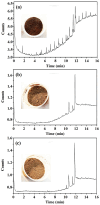Efficient bioremediation of crude oil contaminated soil by a consortium of in-situ biosurfactant producing hydrocarbon-degraders
- PMID: 40473708
- PMCID: PMC12141668
- DOI: 10.1038/s41598-025-05035-8
Efficient bioremediation of crude oil contaminated soil by a consortium of in-situ biosurfactant producing hydrocarbon-degraders
Abstract
Soil contamination by crude oil is a common occurrence during accidental spills, transportation, or refining processes. Bioremediation as an environmentally friendly and cost-effective approach is interesting for treating hydrocarbon-contaminated sites via natural microorganisms to break down or transform the hydrocarbons into less toxic substances. However, the bioremediation process is time-consuming due to the low accessibility of cells to hydrocarbon contaminants in soil. Applying hydrocarbon degraders with the capability to produce biosurfactants during the hydrocarbon degradation pathways could significantly handle the problem. In this study, a bacterial consortium consists Roseomonas aestuarii, Pseudomonas oryzihabitans, Pantoea agglomerans, and Arthrobacter sp. was evaluated for crude oil removal from the aqueous environment and soil microcosm. To examine the effect of supplementary biosurfactants in the bioremediation process, surfactin and rhamnolipid (ratio 1:1) were used at a concentration of 1000 ppm. Our findings indicate the consortium has high potential in removing saturated hydrocarbons from aqueous (removal yield = 96.16% after 9 days) and soil (removal yield = 64.65% after 120 days) environments. The consortium had a significantly higher removal efficiency than the single-cell treatments, possibly due to the species' synergistic effect. The GC-MS analysis confirmed a uniform removal of different molecular weight hydrocarbons by the consortium from soil. However, adding supplementary biosurfactants showed a slight modification in the consortium's performance after 120 days in soil microcosms (removal yield for saturated hydrocarbons was 65.97%). This study showed the potential application of this in-situ producing biosurfactant consortium for bioremediation purposes.
Keywords: Bioavailability; Bioremediation; Soil microcosm; Surfactin. Rhamnolipids; Synergistic effects.
© 2025. The Author(s).
Conflict of interest statement
Declarations. Competing interests: The authors declare no competing interests. Ethical approval: The manuscript does not contain experiments using animals, and it does not contain human studies.
Figures






Similar articles
-
Simultaneous removal of aliphatic and aromatic crude oil hydrocarbons by Pantoea agglomerans isolated from petroleum-contaminated soil in the west of Iran.Arch Microbiol. 2024 Feb 13;206(3):98. doi: 10.1007/s00203-023-03819-y. Arch Microbiol. 2024. PMID: 38351169
-
Bioremediation and reclamation of soil contaminated with petroleum oil hydrocarbons by exogenously seeded bacterial consortium: a pilot-scale study.Environ Sci Pollut Res Int. 2011 Mar;18(3):471-8. doi: 10.1007/s11356-010-0391-2. Epub 2010 Sep 12. Environ Sci Pollut Res Int. 2011. PMID: 20835890
-
In situ biosurfactant production and hydrocarbon removal by Pseudomonas putida CB-100 in bioaugmented and biostimulated oil-contaminated soil.Braz J Microbiol. 2013 Oct 30;44(2):595-605. doi: 10.1590/S1517-83822013000200040. eCollection 2013. Braz J Microbiol. 2013. PMID: 24294259 Free PMC article.
-
Bioremediation of petroleum-contaminated soil based on both toxicity risk control and hydrocarbon removal-progress and prospect.Environ Sci Pollut Res Int. 2024 Oct;31(50):59795-59818. doi: 10.1007/s11356-024-34614-x. Epub 2024 Oct 10. Environ Sci Pollut Res Int. 2024. PMID: 39388086 Review.
-
Fungal-bacterial consortia: A promising strategy for the removal of petroleum hydrocarbons.Ecotoxicol Environ Saf. 2024 Jul 15;280:116543. doi: 10.1016/j.ecoenv.2024.116543. Epub 2024 Jun 3. Ecotoxicol Environ Saf. 2024. PMID: 38833981 Review.
References
-
- Feng, L. et al. Petroleum hydrocarbon-contaminated soil bioremediation assisted by isolated bacterial consortium and sophorolipid. Environ. Pollut.273, 116476 (2021). - PubMed
-
- Michael-Igolima, U., Abbey, S. J. & Ifelebuegu, A. O. A systematic review on the effectiveness of remediation methods for oil contaminated soils. Environ. Adv.9, 100319 (2022).
-
- McFarlin, K. M. & Prince, R. C. in Petrodiesel Fuels: Science, Technology, Health, and Environment Vol. 3 (ed Ozcan Konur) Ch. 44, 911–935 (CRC Press: Taylor & Francis Group, (2021).
-
- Mokrani, S. et al. Bioremediation techniques for soil organic pollution: mechanisms, microorganisms, and technologies-A comprehensive review. Ecol. Eng.207, 107338 (2024).
-
- Wang, S. et al. Advances in research on petroleum biodegradability in soil. Environ. Science: Processes Impacts. 23, 9–27 (2021). - PubMed
MeSH terms
Substances
Grants and funding
LinkOut - more resources
Full Text Sources
Miscellaneous

